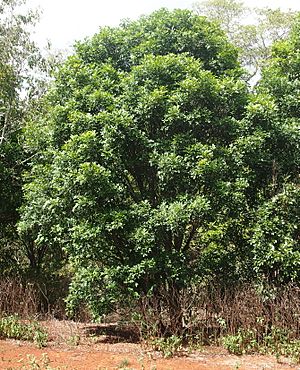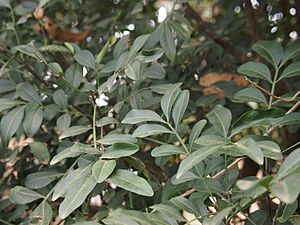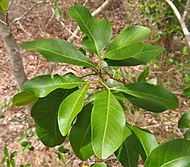Atalaya (plant) facts for kids
Quick facts for kids Atalaya |
|
|---|---|
 |
|
| Atalaya salicifolia (type species) habit (above), foliage (below) | |
 |
|
| Scientific classification |
|
| Kingdom: | Plantae |
| Clade: | Tracheophytes |
| Clade: | Angiosperms |
| Clade: | Eudicots |
| Clade: | Rosids |
| Order: | Sapindales |
| Family: | Sapindaceae |
| Subfamily: | Sapindoideae |
| Genus: | Atalaya Blume |
| Type species | |
| Atalaya salicifolia (A.DC.) Blume
|
|
| Species | |
|
See text |
|
Atalaya is a group of plants that includes eighteen different kinds of trees and shrubs. They belong to the plant family called Sapindaceae. Most Atalaya species, about fourteen of them, grow naturally in Australia. One special kind is found only in New Guinea.
Three other species of Atalaya grow in southern Africa. Two of these are found only in South Africa. The third species grows in South Africa, Swaziland, and Mozambique.
One species, A. salicifolia, is found in many places. It grows in Australia, Timor, and other islands in Indonesia. This plant was the first Atalaya to get a scientific name. It helps scientists understand the whole group.
Contents
Where do Atalaya plants grow?
Atalaya plants grow in many warm parts of Australia. You can find them in rainforests, brigalow scrubs, and monsoon forests. Monsoon forests have a wet summer and a dry winter. Some Atalaya also live in tropical savannas and coastal areas. They can even grow in some dry desert places.
Certain Atalaya species prefer rich soils. These soils often come from limestone or basalt rocks. Sadly, many of these fertile areas have been used for farming. This has caused some special native plants to decline.
Two Atalaya species in Queensland are still waiting for their official scientific names. They have been collected and described, but not formally published yet.
Protecting Atalaya plants
Atalaya plants are found across warmer parts of Australia. This includes Queensland, the Northern Territory, Western Australia, New South Wales, and South Australia. They are not found in Tasmania or Victoria.
Some Atalaya species are quite rare. For example, Atalaya collina trees are known from only two small groups near Gladstone, Queensland. Because of this, the Australian government lists them as "endangered." This means they are at high risk of disappearing forever.
A unique species called Atalaya brevialata was discovered in 2012. It grows only in a small area near Darwin, Australia. This plant is unusual because it grows mostly underground. Its leafy parts above ground die back each dry season. It only grows up to about 45 centimeters (18 inches) tall. Scientists have also listed A. brevialata as "endangered."
In South Africa, some Atalaya species also need protection. A. natalensis trees are rare and have a small habitat. They are listed as "vulnerable," meaning they are also at risk.
In Papua New Guinea, A. papuana grows in coastal rainforests on sand dunes. It also lives in tropical savanna forests. You can find it in areas that are recovering from fires.
How Atalaya got its name
Scientists officially named the Atalaya group in 1847. This was done by a scientist named Carl L. Blume. He used a plant from Timor, Atalaya salicifolia, as the main example for the group.
Later, in the 1960s, Pieter W. Leenhouts described two more species. Then, in the 1980s and 1990s, Sally T. Reynolds described several new Australian species. She also wrote about Atalaya for the important Flora of Australia book series.
Types of Atalaya species
Here are some of the different Atalaya species known to science:
- Atalaya alata – Found in South Africa, Swaziland, and Mozambique.
- Atalaya angustifolia – Grows in Queensland, Australia.
- Atalaya australiana – Grows in Queensland, Australia.
- Atalaya brevialata – Found only in the Northern Territory, Australia.
- Atalaya calcicola – Grows in Queensland, Australia.
- Atalaya capensis – Found only in South Africa.
- Atalaya collina – Grows in Queensland, Australia.
- Atalaya hemiglauca – Found in WA, SA, Qld, NSW, NT, Australia.
- Atalaya multiflora – Grows in Qld, NSW, Australia.
- Atalaya natalensis – Found only in South Africa.
- Atalaya oligoclada – Grows in Queensland, Australia.
- Atalaya papuana – Found in SE New Guinea.
- Atalaya rigida – Grows in Queensland, Australia.
- Atalaya salicifolia – Found in WA, NT, Qld, NSW, Australia; also in Timor, Sumbawa, Sumba, and Leti.
- Atalaya sericopetala – Grows in Queensland, Australia.
- Atalaya variifolia – Found in WA, NT, Qld, Australia.
- New species waiting for official names
- Atalaya sp. Chillagoe (L.J.Webb+ 13226) – Queensland, Australia
- Atalaya sp. Scawfell Island (G.N.Batianoff+ 6098) – Queensland, Australia
See also
 In Spanish: Atalaya (planta) para niños
In Spanish: Atalaya (planta) para niños



